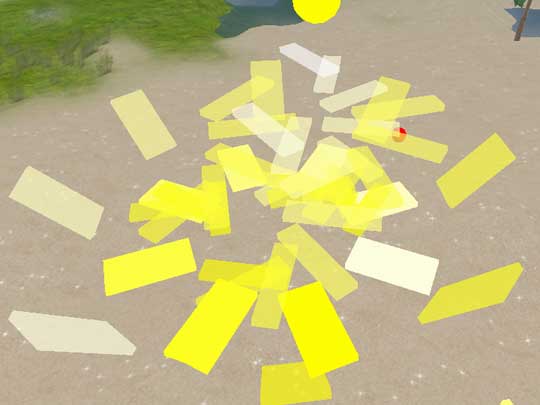Infra Assemblage (2006)

Infra Assemblage was an immersive audiovisual sculpture for Second Life by Adam Nash in 2006.
VIDEO
DESCRIPTION
"Sometimes one goes from chaos to the threshold of a territorial assemblage: directional components, infra-assemblage."
--Deleuze & Guattari, A Thousand Plateaus, p.345 (trans. Brian Massumi)
This work is an attempt to combine the faux-physical respresentational model of Second Life, both the visual metahphor and the physics model, with a programattic form of aleatoric instrument with user input.
These elements combine to make an instrument that is possible only in a realtime 3D environment (though not necessarily a multi-user one) but seems like it 'comes from' the physical world.
Its basic viusal form references that of a 'kinetic sculpture' from the real world. It's semi-aleatoric (chance-based) musical infrastructure owes a concptual debt to a physical device that was installed in the Eames studio for many years. It also references Japanese pachinko machines.
The scale is a rational scale of my own devising, starting at 77Hz and proceeding in intervals based on fractions of 7. It is the same scale as the one used in my work Eudemonia Stellata. The cents-difference of the ratios are derived from Kyle Gann's chart Anatomy of an Octave, http://www.kylegann.com, but the calculations (and therefore any errors) are all my own. The sounds were generated in two methods; a risset drum generator, and a granular/wavetable synthesis based on a sine wave and tabla.
A work like this naturally owes a debt to John Cage, but as David Toop says in "Haunted Weather", Cage's "philosophy of non-intentionality has become a resource, rather than a way of life". Naturally implicit, also, is the work of Brian Eno and others seraching for an endless, subtly transforming continuing plateau of self-determinant music. A lot of work has been done on generative systems and emergent musics, and one of the most exciting things about realtime 3D environments (like Second Life) is the ability to enact these principles fairly easily.
For this piece, initially I tried working with the collision model built in to the Linden Scripting Language, but it was very unpredictable, so I used a very simple algorithm with a state change to achieve the simplisitc 'bouncing' model for the balls, based on multiplying the upward force of the ball by 0.9 on each collision. The starting force (9.9) is only slightly greater than the downward pull of the Second Life gravity model (9.8 m/s^2). The result is a very non-realistic looking bouncing ball that sometimes looks like its made of rubber, sometimes stone :) Sometimes, also, since it is a server-based calculation, the balls freeze in mid-air. All of these characteristics are welcome, as they are the idiosyncrasies of the medium, and this is a work that plays (with) the medium.
The work uses server-based rotation. My other works use client-side rotation, which causes less load on the server and generally gives a smoother rotation. This one needs the server-based rotation in order for the randomly falling balls to know if they have hit a tine or not.
My preferred method of using this piece is to put it into auto-mode and have my avatar stand very near, or inside, the sculpture, then just listen. I enjoy how the sounds emerge from and play with the environmental sounds embedded in the surrounding environment.